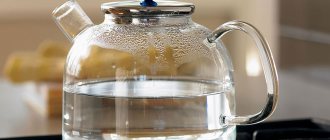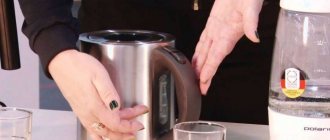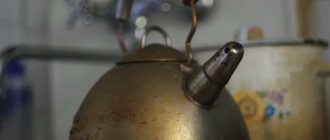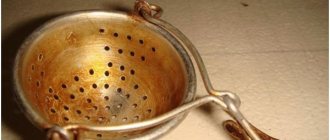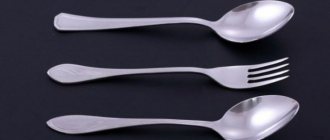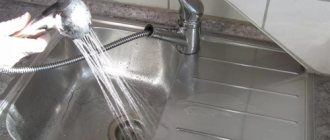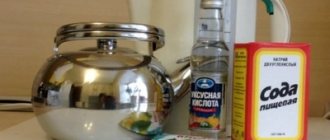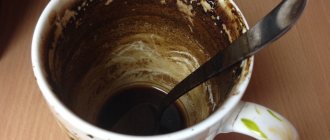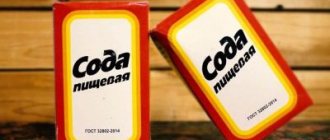Despite the fact that technological progress does not stand still, the modern housewife still has a lot to do. It is simply unrealistic to wash and clean everything in the kitchen every day, and therefore sometimes you need to use something special for cleaning that will help get rid of accumulated dirt.
For example, a teapot... No matter how careful the housewife is, grease and drops during cooking end up on its surface.
Cleaning an electric kettle from scale
Chemicals
For those who need the easiest way to remove scale from an electric kettle, we can advise you: go to an industrial goods store for a special product.
Today there are different anti-scale powders, the instructions are very simple: pour it inside, fill it with water and boil it. The effect of such miracle remedies is immediate and quite lasting.
The main thing when using such powders is to rinse thoroughly after using them: if chemicals get into your morning coffee or evening tea, it can seriously harm your health.
Traditional methods
For those looking for the safest way to descale a kettle, there are home remedies that have been proven over the years.
How to clean the outside of a kettle
You can wipe off dirt using the products available in the arsenal of any housewife. So, how to wash the outside of a stainless steel kettle:
- If it is an electrical appliance, it is cleaned with household chemicals in order to keep it under running water less;
The electrical appliance is cleaned with household chemicals in order to keep it under running water less. - It is advisable to clean a kettle with a whistle for electric and gas stoves using home remedies: wash it with soda. Mustard powder cleanses dirt well. Laundry soap usually remains relevant.
It is advisable to clean a kettle with a whistle for electric and gas stoves using home remedies: wash it with soda.
The process of cleaning stainless cookware, it's time to start
There are many cleaning methods. None of them are worse or better, they will all help you clean the dishes you need, the choice is at your discretion.
- Cleaning with baking soda is the simplest and most affordable method. It is best to warm up a stainless steel kettle a little before attempting to clean the outside of it. To do this, you can warm it up for a couple of minutes or hold it under hot water. Afterwards, take a little soda on a sponge and rub all the walls (do not press too hard, soda can also leave scratches). Let it sit for a few minutes, rinse off the soda with warm water, and then rinse with cold water. Wipe with a dry towel. Instead of soda, you can use tooth powder.
- Another way to clean the outside with baking soda is to dissolve 1 tablespoon of baking soda in 1 liter of water. Place the kettle in a container with this solution and put on fire for 20-30 minutes. Then turn off and let cool. After cooling, clean the kettle from any remaining deposits and soda and rinse under water. Very easy and fast, and the teapot is already clean.
The kettle should be almost completely submerged. By increasing the amount of water, you should proportionally increase the amount of soda.
- Add 2-3 tablespoons of vinegar and 3 tablespoons of soda to a large container of water. It only takes five minutes to keep the kettle on the fire in this solution, then clean it in the same way as with a simple soda solution. Wait until it cools down, clean with a soft sponge, rinse thoroughly, and wipe dry.
- Another remedy for combating grease on dishes is mustard powder. This option will appeal to those who do not like cleaning dishes with chemicals. Apply mustard to the warm surface of the kettle and wipe with a slightly damp sponge. Then rinse off the powder under warm water.
- Chemicals – it’s also important to talk about special products. There is a varied range of dishes for cleaning dishes (Shumanit, Selena, Chistyulya and others). They all have different compositions, which is also a matter of taste. There are budget ones, and there are quite high prices, but the number on the price tag should not guide the choice. For example, Shumanite and Selena are inexpensive, but effective, and can easily clean the outside of stainless steel utensils. Use the selected product strictly according to the instructions. Apply, wait for the required time, try to remove droplets of fat by wiping the surface with a soft sponge. Rinse thoroughly and rinse the container several times in warm and cold water. Then wipe dry.
When using chemicals, never neglect protection. Hands should be gloved, and if possible, wear plastic goggles and a respirator. Do not use concentrated detergents if anyone in your household is prone to allergic reactions.
No matter how hard you try, you still cannot avoid contamination in the kitchen during the cooking process. But you can choose a convenient method for cleaning a glass-ceramic stove, as well as removing carbon deposits from stainless steel pans.
If a little rust appears on a stainless steel kettle (it is better to monitor its appearance and remove it as soon as possible), then you can peel it with regular potatoes. Cut the potato in half and sprinkle salt on the cut area. It is with this cut that you rub the area of rust, then rinse thoroughly under running water.
We suggest you read: How to Remove Chewing Gum from Jeans - wikiHow
Baking soda is also effective against rust. It is necessary to dilute it with water to a paste and apply it to the problem area for 20-30 minutes. Afterwards, brush with a toothbrush, remove any residue with a cloth and rinse with water. If the rust has not gone away, repeat the procedure.
If, while doing important things, you forgot that there was a kettle on the stove and it burned out, the following will help you clean it: salt, activated carbon, laundry soap, powder or special products. Just don’t mix them all together, you need to choose one thing.
The easiest way to get rid of carbon deposits is soaking. Dilute powder, dishwashing detergent or laundry soap in water. Soak the teapot in the solution. Leave for a while until the dirt becomes soft, clean with a double-sided sponge with stiff bristles or a soft brush.
By moistening a sponge and dipping it in salt, you can wash off the fumes if the deposit is not too strong. After the kettle has been rinsed with wet salt, you need to rinse it with cold tap water.
You can clean a burnt kettle using activated carbon. Crush several tablets (at least 10), moisten the surface of the kettle and apply the powder to problem areas. No earlier than 40 minutes later, wipe off the soot and rinse the dishes under water.
All of these methods can be used to clean stainless steel pans. Knowing all these methods, you don’t have to worry about the cleanliness of the dishes and the beauty of the kitchen.
The main thing to do if an enamel pan is burnt is not to put off cleaning until later, but to act immediately. Blackened dishes must first be soaked completely in warm water. It is left for 1-2 hours, after which the black plaque is washed off using detergent and a sponge. This method is suitable if the degree of burning is low. In more complex cases, it is necessary to use special cleaning compounds or resort to traditional methods.
Here's a way to clean an enamel pan from dark deposits:
- You need to carefully remove any remaining burnt food with a sponge and fill the bowl with hot water and soda (2-3 tbsp).
- It is left in this solution for a couple of hours.
- Then the liquid is drained, 1-2 tbsp is poured onto the bottom of the container. l. baking soda and use a sponge to effortlessly remove carbon deposits.
- This method also helps to get rid of yellowness on the enamel surface. Baking soda or fine salt can gently clean such stains.
With any method of cleaning a pan from carbon deposits, it is important to use a medium-hard sponge, a synthetic brush and acid-free chemical compounds. These conditions are important because enamel is a fragile and thin material. It can be damaged by sudden temperature changes, shocks, or prolonged exposure to temperature.
In order for dishes made from this material to last a long time, it is necessary to use it correctly.
If black deposits form, the container should be soaked in water and detergent.
In addition to traditional methods, there are many household chemicals that do an excellent job of removing such contaminants.
The following products are considered the most popular:
- An effective product is “Cif” gel for washing enamel surfaces.
- “Persol” without chlorine perfectly removes black and yellow deposits from metal surfaces.
- Sarma cleans not only enamel pots, but also utensils made of other metals.
- Frosch is the most popular product in the fight for cleanliness of household utensils. Available in gel and powder form.
- "Chistin." It is advisable to use it in case of severe burning of dishes. It comes in powder form and acts as an abrasive.
It is important to choose the right detergents so as not to damage the enamel in the pan. When choosing cleaning products, you should avoid products containing chlorine, acids and harsh abrasives.
How to get rid of the plastic smell in the device?
The new kettle smells like plastic - what should I do? In fact, the plastic itself is odorless, but the kettle smells of dye and plasticizer, which are added in huge quantities to extend the life of the kettle. To get rid of odors, you should use substances that help remove odors from any surfaces.
You will need:
- lemon juice;
- lemon acid;
- lemon peel;
- vinegar;
- soda.
Instructions:
- To remove the smell of plastic from an electric kettle and its taste from drinks, boil the kettle by adding natural lemon juice, citric acid in bags or lemon peels.
- To remove plastic smell using citric acid, fill the kettle with water to the maximum level, pour in 2 25 g bags of acid, boil the kettle, leave the solution overnight, boil the kettle again in the morning, drain the solution, rinse the kettle under running water.
- If you want to use lemon peels, then fill the kettle halfway with the peels, pour water to the maximum level, boil, leave the solution overnight or for at least 12 hours, boil the kettle again, remove everything from it, rinse with running water.
- In addition to these products, you can use vinegar or vinegar essence.
- Baking soda can also help get rid of plastic smells. Fill the kettle with water, add 3 tablespoons of soda, boil the kettle, cool, boil again, drain the solution, rinse the device under running water.
If you add lemon juice, then squeeze the juice from 3-4 lemons, pour into the kettle, add water to the maximum mark, boil, leave the solution for 12 hours, boil again, drain the solution, rinse the kettle with running water. Repeat the procedure if necessary.
To do this, pour water into the kettle, add 2 tablespoons of 70% vinegar essence (or half a glass of 9% vinegar), heat the kettle, but do not bring to a boil, as when boiling the solution will float out (a chemical reaction occurs), that is, it will pour over the kettle . Heat it several times, drain the solution, and rinse the kettle under running water.
Source: kakprosto.ru
kachestvolife.club
Cleaning enamel and metal kettles from scale
Cleaning an enamel kettle from scale is quite simple: almost all traditional methods are suitable for such devices, except for citric acid.
Soda is one of the safest and most effective cleaning agents: it removes even thick gray layers of plaque. How to clean a kettle with soda most effectively?
We suggest you read: How to clean suede from greasy stains
Boil water, add soda at the rate of 1-2 tablespoons per liter (depending on the layer of deposits). Boil again, cool, then wipe thoroughly with a sponge.
It is also very easy to descale a kettle with lemon:
- Pour water;
- We put several slices of lemon there - depending on the volume of the vessel (if there is very little plaque, you can get by with the peel);
- Boil;
- Drain the lemon water;
- Wipe the surface with a sponge.
Features of cleaning different materials
Before cleaning the outside of the kettle, you need to know what is best to use and what method will not damage the piece of cookware. Be sure to take into account what the item is made of.
Aluminum
Aluminum surfaces are washed with hot water and detergent or soap. You can add a little ammonia to the cleaning solution. Aluminum is cleaned with products that do not contain aggressive alkalis. Remove dark deposits on the kettle with a solution of table vinegar and half-and-half water. Then rinse with warm water and wipe dry.
The outside of an aluminum kettle can be quickly cleaned with a cabbage leaf dipped first in the ash. After cleaning, wipe with a piece of flannel and rinse with hot water.
Enameled
Rusty stains from the enamel of the kettle are removed with a swab dipped in vinegar. Grease stains are washed off with warm water and mustard powder. It removes grease and dirt from the outside well if you clean it with a paste of baking soda and soap. You can clean the top of the dishes with fine salt applied to a damp sponge or cloth.
Glass
To clean heat-resistant glass teapots, do not use steel wool, sand, or abrasives. It is better to use chemicals that remove grease well. Grease stains come off easily if you wash with hot water and a spoonful of dry mustard.
Stainless steel
An item will be ideally clean if it is cleaned with a mixture prepared from a tablespoon of salt, flour and vinegar. Apply the paste on the outside. As soon as it dries, wash it off and wipe dry. Metal surfaces are cleaned with coffee grounds taken on a wet sponge or cloth.
Electric
It is better to wipe the device as often as possible so that it retains its original shine. If the kettle is made of plastic, you can scrub the outside of it with baking soda and water. In this case, the device is turned off. Hard-to-reach places can be cleaned with a brush and detergent.
How to clean an enamel pan: 9 home remedies
At home, to wash a burnt enamel pan, place it in hot water for several hours. This will help get rid of the top layer of plaque, which easily gets wet, without harming the surface. Then use a sponge to remove most of the dirt.
The following methods will help you get rid of blackness at the bottom of a pan or ladle:
- The simplest and safest method that will help save a pan from burnt food is to use table salt. The dishes are carefully washed with water and the top layer of soot is removed. Pour 1 glass of salt into the bottom of the container and add 2 glasses of water so that the entire area of contamination is covered with liquid. Then place the pan on low heat and boil for about 30 minutes. After this procedure, the dishes are thoroughly washed in the usual way.
- This method will tell you how to clean a burnt pan using citric acid. The container should be thoroughly washed and a few sachets of citric acid should be poured into the bottom, then filled with water and placed on low heat. This method is good for removing not only carbon deposits, but also scale that forms on the walls of teapots and ladles.
- In difficult cases, many are at a loss as to how to clean an enamel container from a thick layer of burnt food. At home, you can use sand. It will act as an abrasive substance that will remove the ash layer. When using this method, it is important not to rub the enamel itself with grains of sand, otherwise they will scratch it, and in the future any food will burn. Sand is used only to remove a thick layer of carbon deposits. With its help, you can carefully clean the surface of the container.
- In order to save a pan from burnt milk or porridge, just soak it in water and pour baking soda inside. Many housewives wash containers with regular detergent, then add 2-3 tbsp to the bottom. l. baking soda and leave it like that overnight. In the morning, dirt can be easily removed with a sponge and water.
- Housewives often use white to prevent scorching on the pan. It helps restore the former shine and purity of the enamel. You need to work with whiteness with gloves and carefully. This product should not be used to clean dishes used for preparing food for small children.
- Activated charcoal is excellent in combating burnt fat if the pan has darkened or turned yellow after prolonged use. First you need to crush the package of activated carbon tablets. The resulting powder is poured onto the contaminated bottom of the container and left for 30 minutes. Then add a glass of water and boil over low heat. The method removes old stains and black plaque well. It can be used if the jam in the pan is burnt. Activated carbon helps remove such contaminants and does not harm the enamel surface.
- An effective method is the use of mustard for washing enamel dishes. It removes traces of burnt food and soot well. It is advisable to use this substance to remove fresh dirt from enamel cookware. Mustard perfectly whitens the enamel of the pan from the inside and outside. The container must first be cleaned of food residues and ash, after which 2-3 tbsp are poured onto the contaminated surface. l. dry mustard and rub gently with the hard side of the sponge.
- Vinegar at home always comes to the rescue in difficult situations. If fat or food is burnt in a pan, first wash the pan to remove soot and food debris. Then prepare a solution of vinegar and water. Dissolve 4 tbsp in 1 liter of liquid. l. vinegar and pour this solution into the bottom of the pan. Then the container with the solution is placed on low heat and boiled for an hour. During the process, you need to open windows for ventilation and isolate children and animals from inhaling these fumes. After boiling, use a sponge to remove any remaining dirt and thoroughly wash the pan in the usual way.
- Medical alcohol is great for cleaning burnt dishes. It cleans the pan from burning and old fat residues. Housewives prefer to use medical alcohol after cleaning with detergents. It helps restore the shine and whiteness of the metal surface. The burnt bottom of the enamel pan should be rubbed with a sponge dipped in liquid and left for 30 minutes. Remaining fat is washed off with warm water.
We suggest you read How to clean the glossy surface of kitchen furniture
What does it come from?
Perishable equipment, white residue on the walls of the kettle or dry skin are just some of the negative consequences of using too hard water . The culprit is two elements - calcium and magnesium. However, this does not mean that they cannot be dealt with at home.
Hard water, which causes limescale, is a common problem in many households across the country. This difficulty occurs at different scales in different geographic regions.
The hardness of an aqueous solution is determined by the geological composition of the rocks through which it flows. The hardness level can be checked in a laboratory, using the services of special companies, or doing the test yourself. And even faster, the presence of impurities in water can be seen at home on kitchen appliances.
High levels of calcium and magnesium can be present in tap water and, when they get into tea or coffee, although they cannot cause significant harm to health , they remain on the walls of the kettle in the form of scale, which is a chalky whitish bark.
Hard water deposits form hard coatings and become an ideal breeding ground for microbes.
Removing scale from the inside allows you to keep the kettle clean, prevents the formation of pathogenic bacteria and reduces the amount of damage to the surface and bottom.
two types of hard water :
- temporarily hard – can be softened by boiling, usually caused by thermally unstable compounds of magnesium bicarbonate and calcium bicarbonate, known as limestone or chalk;
- constantly hard is caused by undissolved compounds magnesium sulfates and calcium sulfates.
The presence of impurities in water is the factor that causes scale to form in a kettle . The residue remains on stainless steel, aluminum, glass - both traditional and electric kitchen appliances.
It appears as a brownish-gray coating on the surfaces of appliances and reduces the functionality of those appliances over time. They become inefficient and contribute to increased operating costs and energy consumption.
Scale as small as 3mm can result in energy loss of up to 30%.
The higher the water hardness, the more difficult it is to remove sediment from the surface; you have to use more detergents, which not only harm the environment, but also the budget. Especially if you need to clean a metal kettle.
Source: scum.su
How to descale a stainless steel kettle
If you are the happy owner of a stainless steel kettle, then the problem of removing plaque will torment you quite rarely.
On such surfaces, scale forms less frequently, and it is easier to prevent its occurrence: use only settled water, never boil again, and clean the inside of the kettle with your hand and rinse before each use.
Almost all “grandmother’s” methods are perfect for such devices: soda, vinegar, lemon, Coca-Cola and others.
You should avoid using citric acid: it can make the inside of the metal surface a little rough, and scale will form at a faster rate.
Why do you need to delete?
Scale occurs as a result of the settling of limescale on the internal surfaces of the kettle. Limescale is formed from salts, metal particles, and minerals that are present in any unboiled water, and especially a lot of scale forms in hard water. Humanity has not yet found a means to remove scale so that it can disappear once and for all.
Every housewife periodically (about once every two to three months) notices the appearance of white flakes in the water, a whitish or rusty layer on the surface of the dishes, and stone deposits on the spirals of the electric kettle. This means it’s time to descale again. Why does it have to be removed?
Scale causes significant harm because:
- the boiling time of water is extended, there is no energy saving;
- the heating element may fail;
- the kettle will start to turn off before the water in it boils;
- the water will become cloudy, which will affect the quality of the prepared tea and coffee.
Scale occurs on absolutely all heating elements, and it is false to say that if you use filtered water, there will be no problem.
It will happen, but not so often and that’s very good. Alas, household filters do not remove everything that forms limescale.
Scale particles may fall into a cup of drink, and this will be harmful to human health . To prevent this from happening, you can use special filters - nylon, gold-plated. Their use is not very justified - these filters are very short-lived, they have to be washed frequently, which also reduces their service life.
Source: 7rubrik.com
Super remedy for severe soot
Almost all housewives know that it is difficult to wash heavily burnt enamel dishes. But there are special tools that can help in this matter.
At home, you can clean a heavily burnt cup or ladle using vinegar, baking soda and water. These components are mixed, placed in a container and boiled. After which the dishes must be washed with a medium-hard sponge and water.
You can use cleaning agents that are sold in household chemical stores and are created specifically for washing enamel surfaces. They remove old fat, carbon deposits and soot that remain in a frying pan, kettle or saucepan.
An effective method for cleaning a burnt kettle
In situations where the kettle has burned out and you cannot use a metal mesh, the following option without the use of chemicals comes to the rescue:
- 80 g silicate glue;
- 100 g baking soda;
- 10 l. water.
Mix the ingredients in a large container and load the kettle. You can use either a pan or a bucket. Boil for 20 minutes. Remove any remaining soot and carbon deposits with a hard bristled sponge.
To clean a burnt kettle from the inside, it is important to act immediately, because... the bark contains high levels of carcinogens. When the soot has not seriously damaged the dishes, it is enough to fill it with dishwashing detergent, having previously diluted it in water. Leave the utensils overnight and then wipe off any remaining residue with a sponge.
mamamoet.ru
How to clean an enamel pan: 9 home remedies
Scale is not the only threat to the cleanliness and proper operation of kitchen appliances.
Often unsightly stains appear on metal utensils, and the question arises: how to clean the outside of the kettle without damaging the surface?
This is where baking soda can help:
- Dissolve 2 tablespoons in a liter of warm water.
- Then use a sponge to thoroughly but gently clean the surface.
- Then rinse off the remaining product with cold water.
It is also recommended to use toothpaste for cleaning - it does not scratch the metal surface, although it does not hurt to first test on a small area how such a product will affect it.
Various kitchen cleaners without abrasives are very helpful in getting rid of stains.
Grease stains on the surface are a common problem for both electric and regular kettles.
If it is not possible to remove appliances while preparing food to prevent grease from flying onto foreign surfaces, modern grease cleaning products will come to the rescue, of course, without abrasive particles.
The same products that are used to remove carbon deposits from a frying pan, wash microwave ovens or clean irons will do.
Basic folk methods of cleaning at home
Products are washed fastest if you remove dirt from them immediately. Therefore, if the kettle has not been washed for a long time, you will have to work hard. In any case, you need to prepare:
- spacious container;
- sponges with soft and hard surfaces;
- a small brush for cleaning hard-to-reach places, an old toothbrush will do;
- clean cloth for wiping.
Fresh drops of fat can be easily washed off with simple products found in kitchen cabinets.
Baking soda
The powder is used because it is easy to remove fresh and old stains. The kettle should be slightly warmed up and placed in a sink or basin. Now rub the contaminated surface with a sponge, its hard side, sprinkled with soda. After removing stains, wash the kettle several times with warm water.
Vinegar and Coca-Cola
Coca-Cola carbonated water mixed with vinegar effectively removes dirt. They do not take pure acid, but 9% acid. It is poured into soda, maintaining a ratio of 1:3. If the concentration of vinegar is higher, then you need 2-3 teaspoons of essence per bottle of Coca-Cola. A sponge is dipped into the prepared solution, wetting its hard half. Then wipe off the grease stains on the surface of the kettle.
Vinegar and baking soda
The cleaning product is prepared by taking a quarter pack of baking soda. 50 grams of acid is poured on top. When the soda is extinguished, they begin to clean the kitchen utensils. Use a sponge for this purpose. In hard-to-reach places around the spout and handle, pass with a toothbrush dipped in a soda-vinegar mixture. At the end, the clean item is rinsed under running water.
Laundry soap and PVA glue
Heavily dirty and difficult to wash surfaces on the outside of the kettle can be removed with a solution of a bar of laundry soap and 250 grams of PVA glue. It must be diluted in hot water in a special container. The device is immersed there and placed on the stove to boil. After 30 minutes, remove the item and, after cooling, wash it with a sponge soaked in water.
Mustard powder
Dry mustard is often used to clean kitchen utensils. It successfully removes carbon deposits and drops of fat. Prepare the product from a teaspoon of mustard powder and sugar, moistened with water until it has the consistency of a slurry. Lubricate the walls of the kettle with it and leave until dry. Then use a brush to clean off the crust and wash the dishes.
To remove the smell, you can add a little citric acid to the rinse water.
Lemon acid
Fat from an enamel kettle is removed with acidified water. Prepare a solution by adding 1-2 tablespoons of acid to a liter of water. The dishes are immersed in a bowl of water and boiled for 30 minutes. As soon as the solution removed from the heat has cooled, rinse the surfaces with clean water.
Toothpaste
It is best to immediately wipe off stains from kitchen utensils. In this case, squeeze toothpaste onto a small brush and clean the areas stained with grease in a circular motion. It is better to take a paste without a whitening effect, as it contains a lot of abrasive particles.
Cucumber pickle
A heavily soiled kettle is boiled in cucumber brine. The marinade is poured into a basin, and a dirty object is placed there so that the liquid covers it completely. Place on the fire, bringing to a boil. You need to keep it on low heat for another half hour. Then, after cooling a little, rinse with clean water several times.
Apple peelings
Fresh grease stains are removed by the action of malic acid. You can put pieces of apple peel into the boiling water. When heated, it will begin to release acid and corrode various stains on the kettle.
Spoiled milk
Sour milk perfectly removes fat. They wipe stains on dishes and then wash them off after a few minutes. This will make the kettle perfectly clean.
Chemical compositions
If you start using dishes, you will have to deal with contamination with chemicals. They contain substances that will help turn the surface sparkling clean and fresh.
"Antinakipin" and analogues
In the composition of chemical agents such as “Antinoxipin” acids:
- adipic, which corrodes any salt deposits - 5%;
- sulfamic to combat rust and limestone - 30%;
- lemon in the form of sodium citrate salt.
You can use Antiscale when cleaning the kettle not only inside, but also outside. The product is poured into warm water, the device is immersed there and boiled for 20-30 minutes.
"Furman"
Instead of citric acid, the powder contains inorganic acid with an electrochemical corrosion inhibitor. The powder, packaged in 40 gram bags, is added to hot water to remove drops of grease from the kettle.
Rules of care
Soot will not appear on the kettle if:
- wipe the outside with water and vinegar or a drop of detergent every day;
- do not put on fire or turn on an empty device;
- Throw away the water after use.
You should not leave the kettle on the stove while preparing dinner. After all, it is difficult to clean the surfaces of the device from greasy splashes. For boiling in a kettle, it is better to use settled or filtered water.
Stainless steel is widely used in the food industry due to its high performance indicators (it does not oxidize and does not rust). However, caring for dishes made from this material should be done delicately and carefully. However, there are effective and proven ways to clean a kettle from carbon deposits, limescale and even burnt utensils.
